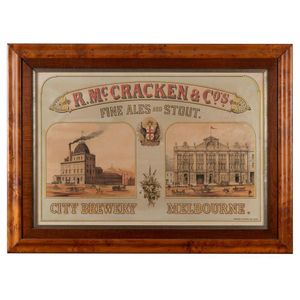Melbourne Brewery Chromolithograph Advertising Poster
You must be a subscriber, and be logged in to view price and dealer details.
Subscribe Now to view actual auction price for this item
When you subscribe, you have the option of setting the currency in which to display prices to $Au, $US, $NZ or Stg.
- Chromolithograph - A chromolithograph is a type of print that uses multiple layers of color to create a detailed and vibrant image. The process was invented in the mid-19th century and quickly became popular for reproducing a wide variety of images, including advertisements, illustrations, maps, and art prints.
Chromolithography is a complex process that involves creating a separate stone or metal plate for each color in the image. The artist or printmaker first draws the image on a stone or metal plate using a greasy substance, such as a crayon or a wax-based ink. This image is then transferred to a separate plate for each color in the image. The plate is then coated with a thin layer of a light-sensitive substance, and then exposed to a light source. The light hardens the parts of the plate that are not covered by the image, creating a raised surface that will hold the ink.
Once the plates are ready, they are inked up with the corresponding color and printed one at a time, with each color being printed on top of the last. The process is repeated for each color, with the final image being made up of many layers of color.
It was widely used in the late 19th century and early 20th century for posters, postcards, advertising and illustrations in books and magazines. However, chromolithography has been largely replaced by modern printing techniques such as offset printing and digital printing, which are faster, cheaper, and more efficient. Today, chromolithography is mainly used for fine art prints and reproductions, as well as for creating limited-edition prints of historical or cultural significance - Huon Pine - Named after the Frenchman who discovered the Huon River in Tasmania, it is an extremely slow growing and long living tree. Huon pine is native to Tasmania, and it can grow to an age of 3,000 years or more. The wood contains oil that retards the growth of fungi, hence its early popularity in ship-building in convict-era Tasmania. The timber is a warm yellow colour, finely grained, and was popular for household furniture in the Victorian era. Interestingly, much Huon pine furniture was made in South Australia. Huon pine is a protected species and only limited quantities are available nowadays, for craftsmen to manufacture small items such as platters, sculptures and other decorative objects.
- Fiddleback - A name given to the pattern of the grain in some timbers, where the lines of the grain are compressed and at the same time wavy. Fiddleback grain is prized as a timber for furniture and musical instruments, and is expensive becasue of its scarcity.
In Australia fiddleback graining is found in blackwood. Other non-native timbers that are sometimes found with a fiddleback grain are mahogany and maple. - Blackwood - One of the best known and most widely used Australian timbers, blackwood (acacia melanoxylon), is a member of the Acacia (wattle) family and grows in eastern Australia from about Adelaide in South Australia, as far north as Cairns in Queensland.
The largest, straightest and tallest trees come from the wet forest and swamps of north-west Tasmania where it is grown commercially.
Blackwood timber colours range across a wide spectrum, from a very pale honey colour through to a dark chocolate with streaks of red tinge.
The hardwood timber has been commonly used in the production of furniture, flooring, and musical instruments in Australia from the late 19th century. However, the straight grain timber is not the most prized or valuable, that honour falls to blackwood with a wavy, fiddleback pattern, which is used both in the solid and as a veneer. Fiddleback was only used on the finest examples of furniture.
This item has been included into following indexes:
Visually similar items

Victorian mahogany pharmacy cabinet with gold hand painted advertising, 68 cm high, 77 cm wide, 26 cm deep

Map mid 19th century, 'Colonies Francaise', 'Martinique Amerique ' by Victor Levasseur, c.1856, handcoloured etching, framed, 30 cm x 42 cm

Australia v England Ashes Series in Australia, 1894-95: A sepia-toned albumen photograph of the Australian team that won the 4th Test in February 1895 at the S.C.G. The image, 15 x 21.5 cm; framed and glazed, overall 25 x 30 cm. Although England won the Se

Framed display Canada cap and shoulder badge set with photo of corps re-Union Toronto 1934
